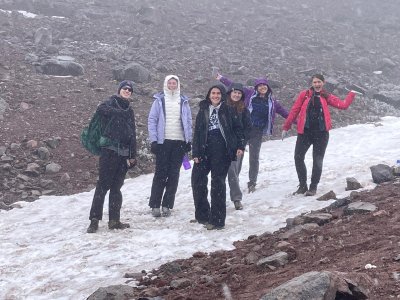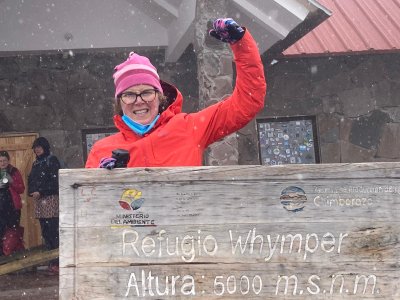Postcards from Ecuador: Lessons in geology and endurance on the slopes of Chimborazo
Day 9 of the Honors College study abroad in Ecuador saw the group climb from the mid altitude cloud forest city of Baños - probably the favorite town of the trip so far for the group because of its friendly, laid-back vibe - to the high altitude city of Riobamba.
Along the way was an incredibly important stop – the national park at Chimborazo, Ecuador's highest point at more than 20,000 feet, almost double the height of Mount Baker.
As the night bus inched its way higher, the scenery began to change, as did the topography – a perfect opportunity for three students, Annabelle Carozza, Braden Brask, and Noah Goodwin-Rice, to give their presentation on the impact of an active volcano on the surrounding area. The trio pointed out lahars, ash flows and sediments, and kept an eye out for the moraines left by retreating glaciers.
Carozza presented in great detail about the types of rocks littering the landscape.
“These scoria were formed when basaltic magma was erupted from the volcano. This basaltic magma is more mafic in composition, which is why they have that dark color,” she said. “Most people just call them ‘lava rocks’ but the correct name is scoria.”
Brask went into fine detail on the formation of Chimborazo’s three summits, their ages, and their heights; Goodwin-Rice talked about what types of flows and topography the group would see as they descended.
After the presentations, the group was well armed for what it would see higher up.
Just to get to the trailhead to meet the group’s guide, a local Kichwa woman named Olga, the bus passed through the gates of the park at more than 15,000 feet.
Some of the group, including this writer, found the altitude of Quito at about 9,000 feet to be impactful. For example, carrying one’s luggage up two flights of stairs could leave some feeling quite winded. But 15,500 feet was a different animal altogether, and the group set out with Olga at a slow, deliberate pace.
There were two “refugios,” or shelters, along the way as the trail snaked its way upward. As is so often the case with Ecuador’s stratovolcanoes, the top was swathed in clouds as the group encountered an eerie, almost lunar landscape with very little visibility.
Only the hardiest of plants and animals can live in such an environment, from a very-high-altitude cousin of the alpaca called a vicuña to the carunculated caracara, an Andean hawk.
The group climbed through an at times stiff breeze with temperatures in the low 40s and off-and-on sleet to the first refugio, where many turned around; others pushed onto the second refugio, at exactly 5,000 meters or 16,404 feet.
“Can you believe we were in the Amazon two days ago?” Goodwin-Rice asked his group mates.
Regardless of how far they climbed, the exhausted group tumbled back into the night bus for the trip to Riobamba, but not before a fortuitous parting of the clouds revealed Chimborazo in all its glory.

